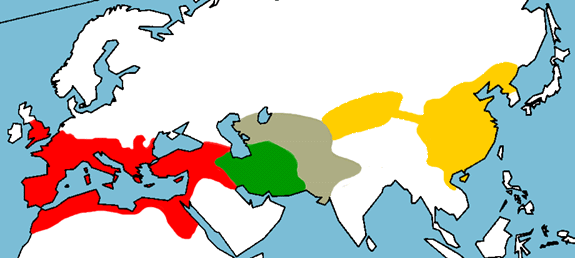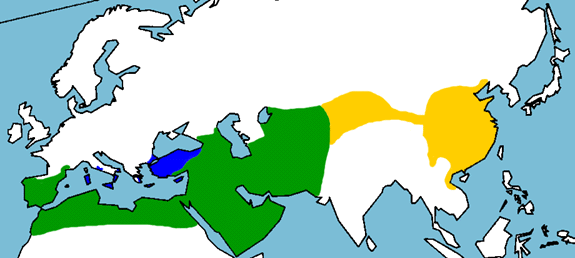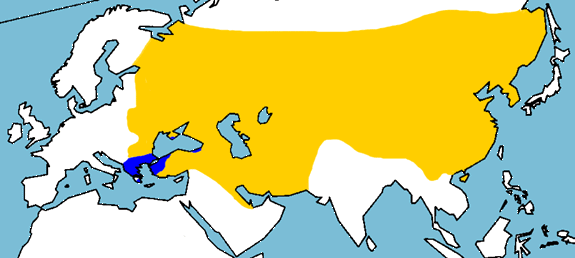
This map shows "Classical" civilization at its height. Almost the
whole
of the civilized (i.e. literate) population of the world resided within
four great Empires: Roman (red), founded in 338 BC, Parthian (green),
founded
in 247 BC, Kushan (taupe), founded c. 60 AD, and Han (yellow), founded
in 221 BC. This was the first period in which Eurasia was spanned by
Empires.
The two outer Empires were the largest, with populations around 50
million
(the Han Empire probably somewhat greater than the Roman). The two
inner
Empires were much smaller, with populations around the 5 to 10 million
mark. Although the Roman Empire had parity with the Han Empire in
population
and land area, economically the latter was significantly more advanced.
This was reflected in trade between the Empires, which was conducted
via
the Silk road through central Asia, and, from the 160s, through
sea-voyages by Roman merchants. This trade was characterized by the
flow of Chinese goods westwards, and Roman raw materials eastwards. A
consequence
of this was a growing scarcity of precious metals in the Roman Empire.
This lead to the repeated debasement of Roman currency in the century
following
170, and the effective cessation of trade with China. Despite this, the
Roman Empire far outlasted the other Empires in
this map, which all fell in the 220s.

By this time, the Roman Empire (blue) was small compared to the other great Eurasian Empires: the Umayyad Caliphate (green) and the Tang Empire (yellow). Their respective populations were perhaps around 7, 35, and 50 millions. The silk road (evident as in 116 in the westward extension of the Chinese Empire) was once again a thriving trade route between east and west. The Umayyad Caliphate was the direct successor to the state founded by Mohammed's followers in the 630s. In 754 its territories were at their height, but a civil war was in progress which saw the replacement of the Umayyads by the Abbasids in Asia and Africa, with the Umayyads keeping only Spain after 756. The Moslem world would never again have a single ruler, and the process of political disintegration continued until about 900. Around the same time, the Tang Empire, which had been founded in 618, collapsed in civil war. The Roman Empire soldiered on.

Here the Roman (Byzantine) Empire is completely dwarfed by one
Empire
that dominated Eurasia: that of the Mongols. Their populations
reflected
this disparity. The Byzantine Emperor had perhaps 3 million subjects.
Despite
depopulation caused by Mongol pillaging, Kublai Khan had perhaps 120
million
(three quarters of whom were Chinese). The Mongol Empire had been
founded
by Temujin (Chingis Khan) in 1206 and reached its maximum extent
in c.1280.
From 1259 it was divided into four Khanates. However the Chagatai
Khanate
(central), the Golden Horde (north-west) and the Ilkhanate (south-west)
remained nominally under the sovereignty of Kublai Khan of the Great
Khanate
(east) until his death in 1294. Although it looks threatening to the
Byzantine
Empire, in fact the Mongol Empire helped the Byzantines to recover from
the fourth crusade by reducing the power of its neighbours to the east
(the Seljuk Sultanate) and north (Bulgaria). The Roman Empire outlasted
by two generations the Great Khanate, which was
overthrown
by the Ming dynasty in China in 1389.
The last of the original Mongol Khanates, the Chagatai Khanate,
lingered
on in remote central Asia until 1678.